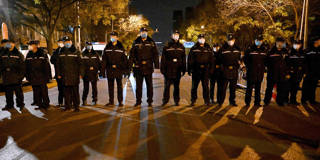The good news for the Chinese people is that the recent protests were dispersed with little bloodshed, and the end of pandemic restrictions is finally in sight. The bad news is that the public’s rejection of the government’s COVID rules raises the political stakes of the next controversial policy.
CHICAGO – China’s leaders always knew that they would have to abandon their zero-COVID policy eventually, and that the longer they waited, the more painful the transition would be. Yet they seemed mired in the policy, unable to leave it behind and move on. Then, an apartment-building blaze in locked-down Xinjiang killed ten people whose escape was thwarted by locked doors and blocked entrances. This sparked China’s largest anti-government protests since the Tiananmen movement of 1989 and became the catalyst for the authorities’ decision finally to begin easing restrictions.
The protests were an expression of the frustration and anger accumulated over nearly three years of aggressive lockdowns, with families stuck in their homes for months, unable to visit dying loved ones, access regular health care, or even buy food.
Compared to 1989, the government’s response was notably moderate: police dispersed demonstrations with relatively little violence, though this partly reflected their ability to use new surveillance technologies to track down and discourage protesters. China’s government has also apparently listened to the protesters. It has now scrapped some of its harsher COVID policies, such as the requirement to quarantine in state facilities.

CHICAGO – China’s leaders always knew that they would have to abandon their zero-COVID policy eventually, and that the longer they waited, the more painful the transition would be. Yet they seemed mired in the policy, unable to leave it behind and move on. Then, an apartment-building blaze in locked-down Xinjiang killed ten people whose escape was thwarted by locked doors and blocked entrances. This sparked China’s largest anti-government protests since the Tiananmen movement of 1989 and became the catalyst for the authorities’ decision finally to begin easing restrictions.
The protests were an expression of the frustration and anger accumulated over nearly three years of aggressive lockdowns, with families stuck in their homes for months, unable to visit dying loved ones, access regular health care, or even buy food.
Compared to 1989, the government’s response was notably moderate: police dispersed demonstrations with relatively little violence, though this partly reflected their ability to use new surveillance technologies to track down and discourage protesters. China’s government has also apparently listened to the protesters. It has now scrapped some of its harsher COVID policies, such as the requirement to quarantine in state facilities.